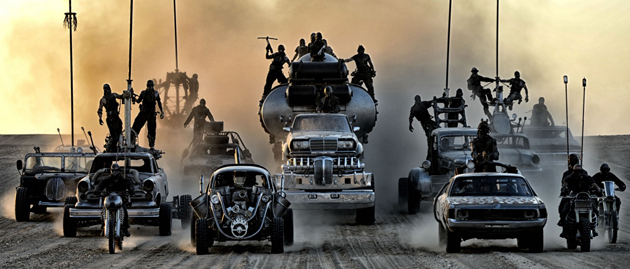Colin Gibson

horrible it is and you keep thinking if not for the grace of God you’d be pushing a cable under a house plugging in somebody’s toaster. So enjoy. We’re a very lucky group. If nothing else it’s always better than a real job.
AS: How involved in the actual production design is George Miller?
CG: If you sit down for a year or so and do two-thousand storyboards you definitely have a handle on what you want. But he gave us a great amount of leeway. He was also very busy doing tap-dancing penguins for Happy Feet at the same time. We’d get three month stretches where we didn’t see him and we could move ahead making our own version of great progress. As Mr. Fisk mentioned I’d rather rebuild it again afterwards but at least be able to show what it could be. I would, in my own fascist system, sort out which vehicle belonged to whom and George would come in and say, No, I love this one so much it has to become this. I refuse to blow it up that early in the movie. And then he’d tie it all back together with his rather incredible obsession and imagination.
AS: What would you say that you like most about designing movies?
CG: The chance to think about something. Sometimes we just don’t think about stuff enough. What I love is you get to look at a script and you get to go into it as deeply as you allow yourself. And that gives you the chance to break it down and to start to understand how the component parts work and how they affect other people. I think it’s a fantastic way to look at how we communicate and how we think, how we feel. And if you think about it enough and you have enough good people around you they can turn what could have been the bad poetry in your bedroom into something the whole world can share.
AS: When someone hands you a script what are some of the first things you do?
CG: I read it and then go back and start over again almost immediately. I break down the ideas that are in it. If it’s a good script I can find three or four arresting images. You come up with those three or four arresting graphic moments and then you go back to the director or whoever’s offered this to you and say, What about this? This is how I imagine you could get that across. Does this tap into something? Then you start to come up with a visual language to go with the written language. I’m wedded to the word as much as I am to the picture. If you discover something that strikes a chord with you, usually it can echo with an audience as well.
AS: Do you always work with the same crew?
CG: Part of the great tragedy of working on a movie that I was first offered in the year 2000 is that sadly the crew changed. It changed a lot, more than I would have liked. But I do enjoy working with different people. I do like the idea of going to different countries. It was fantastic being in China and having only a local crew for the first seven weeks of the build. Obviously there are people who you know and love and